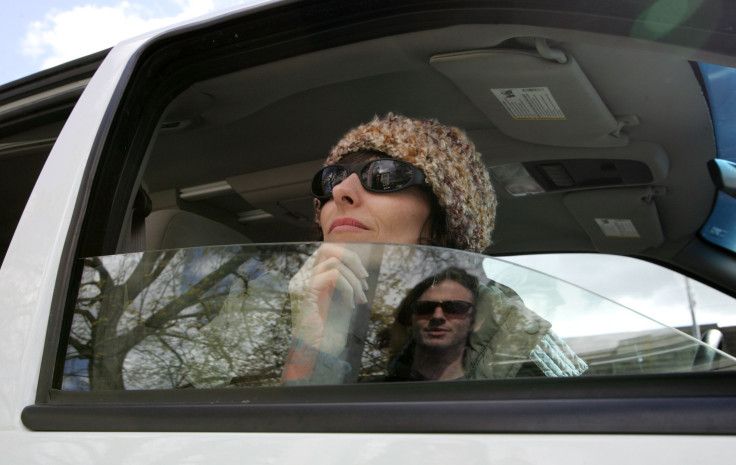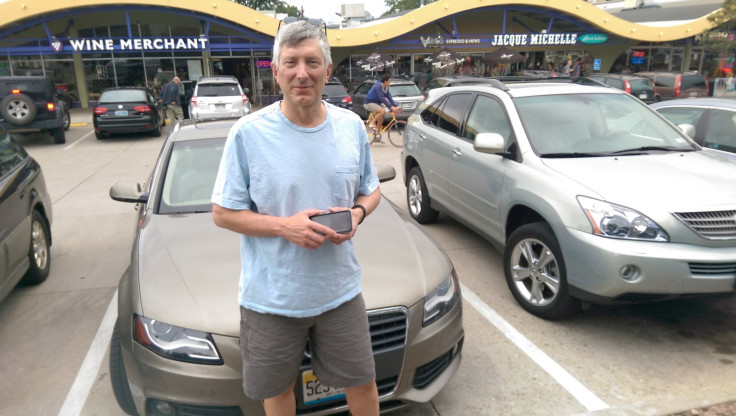Marijuana Legalization 2015: New Smartphone App Warns You When You’re Too Stoned To Drive

BOULDER, Colorado -- Marc Silverman sits at an open-air table outside a busy coffee shop, tapping away at his iPhone as colorful images pop up on his screen. He’s not playing the latest time-wasting smartphone game. He’s engaged in something far more serious. The 59-year-old, dressed in a wrinkled T-shirt and flip-flops, is demonstrating a $5 app he developed with the help of the country’s most famous pro-marijuana organization to prevent people from getting behind the wheel while high.
The NORML -sanctioned app, called Canary , quickly subjects users to four basic tests: a memory challenge where you have to recall six numbers that briefly appear on screen, a reaction-time game where you have to quickly identify a particular icon from a series of images that pop up, a time-perception assessment where you have to count off 20 seconds in your head as accurately as possible and a balance test that uses your phone’s accelerometer to gauge your ability to stand motionless on one foot. Then, comparing your results to a personalized performance baseline based on your past attempts at the app or norms built into the program, Canary determines whether your performance is impaired. At the end of the three-minute session, a green light means you’re good to go, a yellow light means you should think hard about driving, and a blinking red light means stay off the road.

The idea is simple, but Canary aims to help solve the troubling and complicated problem of marijuana and driving. Identifying and preventing marijuana impairment has become a major law-enforcement priority. But while technologies like marijuana breathalyzers have attracted substantial attention and funding, many experts question whether devices testing people’s blood or breath will ever be able to accurately determine whether a driver is too high to be on the open road. Could Silverman’s basic app succeed where more ambitious attempts have failed?
Quest For A Marijuana Test
As the legalization of recreational and medical marijuana spreads across the country, preventing marijuana-related driving accidents is a major public-safety concern, not to mention a political imperative. There’s a social justice incentive behind accurate marijuana impairment tests as well: Since African-Americans are far more likely to be pulled over and arrested for marijuana offenses than whites, an objective way to determine who’s high and who’s not could help level the playing field.
In every state, it’s long been illegal to drive while impaired by any controlled substance, and marijuana is no exception. In most states, “effect-based” driving under the influence of drug (DUID) laws require prosecutors to prove marijuana impairment, which usually includes a police officer’s assessment of driving state, roadside sobriety tests and biological tests that attempt to discover marijuana in the driver’s system. But now five states -- Montana, Nevada, Ohio, Virginia and Washington -- have passed “per se” DUID laws for marijuana, meaning that if police catch a driver behind the wheel with a certain level of marijuana in his or her system, that alone means they’re considered guilty of DUID, similar to blood-alcohol laws for driving. What’s more, according to Christian Denmon of the Florida law firm Denmon & Denmon , 15 states have passed zero tolerance laws stating that if you’re on the road with any amount of marijuana in your system, you’re busted.
But how exactly do you determine how much marijuana is in someone’s system?
Urinalysis and hair strand testing are often considered unreliable for DUID convictions, and quickly obtaining a blood test for someone who’s been pulled over is a logistical headache. “It would be nice to have a tool to be able to quantify and verify that what [officers] are seeing is consistent with cannabis impairment,” says Colorado State Trooper Jerry Sharp, who’s among the 10 percent or so of state troopers who are trained as drug recognition experts. While Sharp thinks officers are adept at identifying impairment, it’s not always clear marijuana is the culprit. “Everybody has an idea of what drunk is, but we as a society are still working on what we envision as high,” he says.
It’s why many people are excited about the idea of marijuana breathalyzers, devices that can detect traces of marijuana in someone’s breath. Companies hawking breathalyzer prototypes have become a staple of cannabis trade shows and Colorado, which in 2013 passed one of the more lenient versions of a marijuana DUID law, handed out a $250,000 grant to Lifeloc, a Colorado-based company, last year to help develop such a device.
The problem, says Lifeloc CEO Barry Knott, is that making a marijuana breathalyzer is more difficult than making one for alcohol. “The primary compound in marijuana that causes impairment is delta-9 [tetrahydrocannabinol],” says Knott. “The good news is just like alcohol, delta-9 is expelled in your breath if you have it in your system. But delta-9 is exhaled in the breath in much smaller quantities than alcohol vapor, so it’s much more difficult to collect and detect.”
While some companies are promising that a functional and vetted marijuana breathalyzer is just around the corner, Knott urges caution. “It took 30 years for alcohol breathalyzers to get to where they are today,” he says. “I don’t think it will take that long for marijuana breathalyzers, but it might take 10 years.”
Whether or not a marijuana breathalyzer ever makes it to market, many argue the idea behind such devices, not to mention all of the per se and zero-tolerance laws that have been passed around the country, is inherently flawed. The problem is that unlike blood-alcohol levels, traces of marijuana in someone’s system don’t equate to the same levels of impairment from person to person.
For example, regular marijuana users could have marijuana levels in their system greater than legal limits in certain states without any impairment at all. That’s why even the National Highway Traffic and Safety Administration concedes that “It is difficult to establish a relationship between a person's THC blood or plasma concentration and performance impairing effects.”
“There is a lack of research and understanding of the impact marijuana has on motor skills and executive functions, and I don’t think detecting levels of anything related to THC in your body is a fair way to go about it,” says Emily Paxhia, co-founder of the marijuana investment fund Poseidon Asset Management. “If there is a detector out there and there is not proof that THC levels are attached to impairment, it could end up putting more people in prison, which is not what we want.”
Measuring Performance, Not Chemicals
This is where Marc Silverman comes in. “I am not a marketing guy,” says Silverman, sitting at the Boulder café. In conversation, he tends to meander into interesting, lengthy asides, rather than stick to the pithy, superlative sound bites favored by local startup whizzes. And he originally planned to call his iPhone app “The Responsible Citizen,” until a more media-savvy colleague suggested Canary, as in “Canary in a coal mine.” (Not to be confused with Canary, a marijuana-delivery startup in Seattle that is now part of a different marijuana company called Dave.)
But those who have gotten to know Silverman are bullish on his invention, no matter how he describes it or what it’s called. “He contacted me a few times by e-mail over a period of some months, and at first I thought this was just another guy interested in pot and driving,” says Leonard Frieling, a former judge turned cannabis attorney who helped legalize marijuana in Colorado. “I didn’t realize just how effective and powerful he was.”
Now Frieling is a collaborator on Canary.
“This tool ideally allows cannabis consumers to take control and identify when they present a traffic-safety risk or when they may be under the influence,” says Paul Armentano, deputy director of NORML, which is actively pushing Canary, the first time it’s ever endorsed a third-party app. “I believe this is information that all responsible marijuana users will want to know.”
The secret to Canary is that it doesn’t focus on potential markers of impaired performance, like levels of delta-9-THC in your breath, but instead on performance itself. Silverman has a background in such measurements; previously he founded a California-based company called Performance Factors that allowed companies ranging from Fortune 1,000 companies to defense contractors to use a software program, rather than drug tests, to screen for performance impairment.
“Drug tests such as urinalyses or blood tests are retrospective,” says Silverman. “The best those tests can do is assess lifestyle: Did you consume pot at some time? It has absolutely no impact on whether you can perform. On one hand, it’s kind of unfair to go after someone who might have smoked a joint on Thursday and tested positive on Monday. The flip side of the coin is someone might have been up all night caring for the homeless, but you might not want them driving a school bus the next day.”
That’s why, two years ago, Silverman began tracking down the most accurate evidence-based measures of personal impairment and building them into a smartphone app. The result is billed as a marijuana app, but can gauge all kinds of impairment, whether from alcohol consumption or lack of sleep. “It needed to be accurate, it needed to be credible, and it needed to be efficient,” says Silverman, who hopes to eventually develop an Android version. “You don’t have to have needles stuck in your arm.”
Since it launched several weeks ago, Canary has been downloaded more than 10,000 times and is attracting attention from major marijuana players. “I think it is interesting on many levels,” says Paxhia of Poseidon Asset Management, who hasn’t tried the app yet. “While I don’t really know how accurate it is and how it tests against your baseline, I do think it is interesting that they are trying to understand how you are performing and functioning.”
Silverman’s app doesn’t aim to solve one of the other major problems associated with marijuana and driving: How exactly the authorities should determine whether you’re too high to be behind the wheel. “I wouldn’t feel comfortable allowing for law enforcement to use it,” he says, explaining people need to establish personal baselines in the app to obtain the most accurate possible results. Nor is he interested in making users’ past results accessible to the police. “The information is stored on your phone. It is not uploaded anywhere," he insists. "Our privacy policy is absolute.”
Still, he hopes Canary will discourage people from getting on the road while stoned in the first place, thereby preventing them from getting pulled over – or worse. To demonstrate how it works as a deterrent, he opens the app and purposely blunders through the tests, wildly underestimating his 20-second count and waving the phone around instead of keeping it still against his chest as he balances on one foot. At the end, he’s faced with a stoplight, ominously flashing red.
Will such a warning be enough to keep a marijuana-impaired driver from getting on the road? Possibly, if there’s any truth to one of Silverman’s favorite jokes. “What’s the difference between a drunk driver and a stoned driver?” he asks, cracking a smile. “A drunk driver sees a stop sign and drives right through it. A stoned driver stops and waits for the sign to turn green.”
© Copyright IBTimes 2024. All rights reserved.





















